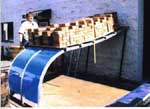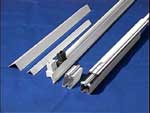| |
|
|
| |
|
Engineering
Load Test
|
 |
|
Glaze:
1/8"
Acrylic
Beams:
T5 Aluminum |
Span
Length: 10'0" |
Width:
4'2" |
Centers:
25" |
Load:
50.7
lb/sq/ft |
Load/Rafter:
105.7
lb/lin. ft. |
Deflection
(inches):
Vert.
= 5.08 in. |
Deflection
(inches):
Horiz.
= 0.64 in. |
| Note:
Original sheet
thickness was 1/8",
today we utilize
3/16" as standard
glaze thickness. All
center to center Rafter
dimensions are now 26
1/8". |
|
| |
|
|
| |
|
Aluminum
Rafter Specifications
|
 |
|
Aluminum
structural members: Are
all extruded T-5 6063
architectural grade aluminum
alloy.
Exterior Finish:
Factory raw, White/Brown spray
enamel, or electrostatic powder
coat custom color.
Nylon Plugs:
Proprietary design - White/Brown
fastening members.
Glaze Seal:
"Santoprene" cup seal -
4 per full Rafter/Barcap length,
2 upper & 2 lower. |
Acrylic
Sheet: Physical Property
Specifications
Purpose
is to encourage the proper use of acrylic
sheet plastic in construction, and to aid
architects in designing and preparing
specifications consistent with the
properties and characteristics of the
material. [ Tables and literature from
Rohm & Haas, Philadelphia, PA, CO-EX
Corp. Rocky Hill, CT.] Commercial grade acrylic sheet is suitable for
most building glazing applications.
|
Breakage Resistance
The figures below show that various thickness
of acrylic sheet have greater impact resistance than other types
of glass when impacted with a hard object, such as a stone.
IMPACT RESISTANCE OF ACRYLIC SHEET AND
OTHER MATERIALS
| Material |
Nominal Thickness: |
Energy to Break (ft-lb) |
Acrylic Sheet
Acrylic Sheet
Acrylic Sheet
Acrylic Sheet |
2.5 mm
3.0 mm
4.5 mm
6.0 mm |
3.0
4.7
11.1
18.1 |
Single strength Window Glass
Double Strength Window Glass
Plate Glass
Plate Glass |
.100 in
.125 in
.187 in
.250 in |
0.8
1.8
2.0
1.0 |
| Laminated Safety Glass |
.250 in |
1.1 |
Rough Wire Glass
Polished Wire Glass |
.250 in
.250 in |
2.2
0.4 |
AIR CANNON IMPACT STRENGTH
Acrylic Sheet
Nominal Thickness (mm) |
Baseball ( 0.32# ) |
Steel Tipped Dart
( 0.6 lb 1/2" Rad. Tip ) |
3.0
6.0
9.0
12.0
18.0
24.0 |
47 mph
84 mph
105 mph
147 mph
184 mph
220 mph |
5 ft.lb.
16 ft.lb.
27 ft.lb.
40 ft.lb.
53 ft.lb.
68 ft.lb. |
Light Transmittance
The colorless form, Acrylic sheet is as transparent
as the finest optical glass. Its total light transmittance is 92
percent, and haze measurement for colorless sheet averages only
1 percent.
SOLAR ENERGY TRANSMITTANCE and SHADING
COEFFICIENTS
| Acrylic Sheet |
Transmittance ( % )
|
Transmittance ( % )
|
Shade Coefficients
Vertical |
| Visible Light |
Solar Energy |
2370 Bronze (Dark)
2412 Bronze (Med.)
2404 Bronze (Light) |
10 %
27
49 |
20 %
35
56 |
0.46
0.58
0.75 |
2111 Green
2092 Green
2069 Blue |
77
26
55 |
76
57
71 |
-
-
0.89 |
| Colorless ( Clear ) |
92 |
85 |
0.98 |
- 2412 Bronze is our standard
(recommend) sheet in bright solariums.
- Super White Translucent
grades are preferred in south face roof areas for alleviation
of extreme heat build-up in solariums - this transmits and bathes
areas below in a natural cool white light plus delivering all
your required light for the growth of plants, yet shades the area
for human activity.
Ultraviolet Transmittance: Regular Acrylic glaze sheet (
G & MC ), will block some portions of the UV spectrum, but special
grades are required when all ( UF-3 ) or most ( UF-4 ) of the UV
needs to be absorbed. Weight
Acrylic Sheet is approximately less than 50%
as heavy as glass and 43% as heavy as aluminum.
Lexan "MacroLux" Panels
[ double wall extruded sheet ] is 1/8 the weight of glass.
COMPARATIVE WEIGHTS (lb/ft² )
| Thickness (mm) |
Acrylic Sheet |
MacroLux Panels |
Glass
Single Glaze |
Glass
Double Glaze |
6
8
10 |
1.45
1.93
2.92 |
0.266
0.350
0.410 |
2.07
4.10
5.12 |
6.15
8.19
10.24 |
Total Energy Transfer
The amount of heat conducted
throught Acrylic glazing is lower than for glass of the same thickness.
U-Factor: ( BTU/hr/sq.ft./ ° F
)
While most household cleaners can safely be used
with acrylic sheet, the material is affected by alcohol, paint thinners,
turpentine, and similar petroleum solvents. To clean paint and grease,
utilize NAPHTHA or KEROSENE for safe removal. Regular cleaning with
a mild dish detergent and plenty of water is preferred, dry with
clean cotton or air dry. A good grade of automobile wax can be applied
as a polish, and is very useful in removal of minor surface abrasions.
Acrylic sheet has proved its ability to withstand
weather and sun exposure with negligible loss of light transmission
and clarity. The manufacturers warranty expresses a 10 year guarantee
of less than 3% CHANGE in light transmission and clarity within
this interval. No other type of plastic offers this assurance of
satisfactory outdoor performance.
When acrylic sheet is heated to its optimum forming
temperature (approximately 325°F - 350°F), it becomes soft and pliable,
and can be formed to almost any desired shape. As the material cools
in its formed shape, it stiffens and retains the shape to which
it has been formed. This permits architects to specify complex designed
panels in small quantity at reasonable tooling costs.
Cold Forming
Flat sheets of acrylic can be cold-formed ...
bent while cold to a smooth contour ... and held to the radius by
springing the material into a curved channel support. The recommended
radius of curvature for "G sheet" should be at least 180
times the thickness of the sheet. Minimum Radius of Curvature for Cold-Formed
Acrylic Sheet
| Sheet Thickness (mm) |
Min. Radius (in) |
1.5 mm
3
4.5
6
8.5
12 |
11 in
21
32
42.5
60
86 |
Our standard minimum radius for 4.5 mm sheet
is 36"
Acrylic sheet offers equal to or better sound
loss characteristics than glass. It also has much better breakage
resistance, so it can be used as a transparent sound barrier to
reduce noise levels and increase safety at the same time. Comparison of Noise Reduction Characteristics
of Acrylic Sheet and Other Materials
| Construction Material |
Approximate dB (A) Noise Reduction |
Acrylic Sheet 3 mm
Acrylic Sheet 6 mm
Acrylic Sheet 12 mm |
25
29
33 |
Glass (1/8")
Glass (1/4") |
25
27 |
Plywood (1")
Steel (1/8")
Sheet Lead (1/16")
Wood Stud Partition (4") |
26
37
38
38 |
Thermal Expansion & Contraction Factor
Due to the thermal expansion and contraction,
acrylic sheet is subject to greater dimensional change than other
materials with which it is used in construction. This is factored
into account when dimensions are laid out for any project. Considerations
must be given to the overall temperature gradient ( max. & min.
values ) that the glazed structure will be subjected to, and allowances
are made to the sheet dimensions according to those values.
Thermal Expansion and Contraction Factor
| Material |
Expansion Coefficients ("/"/°F) |
Typical Modulus (psi) |
Acrylic Sheet
Aluminum
Steel
Plate Glass |
0.0000410
0.0000129
0.0000063
0.0000050 |
450,000
10,000,000
30,000,000
10,000,000 |
Example: (Sheet Location: = 25 1/2"
x 14' ) If the ambient temperature at time of dimensional cutting
is room temp. - then sheet is trimmed to 25 1/4" x 13' 5/8".
Thereby, if sheet is cold at dimensioning, you must realize it is
now contracted, and if the sheet is hot at time of trim, the sheet
may be fully expanded. You therefore trim to what the opposite extreme
temperature would consist of. Generally, on a sheet at 14 ft., the
max. off-cut is approx. 1/2" - 5/8" in length, and approx.
3/16" to 1/4" in width. For smaller sheets, the maximal
length off-cut is reduced proportionally. Temperature / Humidity Bowing
Different temperature and/or humidity conditions
on the inner and outer surfaces of thinner acrylic sheet may cause
sheet to bow somewhat in the direction of the higher temperature
and/or humidity. However, this type of bowing is reversible, and
the sheet will return to its original flatness once the temp./humidity
differentials are equalized. Bowing does not
affect visibility through flat transparent sheet, but may cause
distorted reflection. In translucent or opaque panels where visibility
through the material is not required, this nature exhibits a specular
disguise to reflective distortions. This will not occur in curved
glaze, cold formed or heat formed. This event is lessened by use
of thicker glaze panels on narrow width dimensions.
Service Temperature
The allowable continuous service
temperature range for Acrylic sheet is 170° F to 200° F for exterior
applications.
To avoid stress crazing [ light surface checking
of panel ], design stress limits for continuously imposed
loads should not exceed 1500 psi for acrylic "G" sheet,
and 750 psi for acrylic "MC" sheet at or below room temperature. |